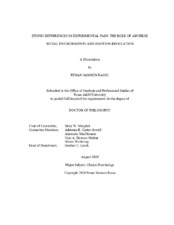Ethnic Differences in Experimental Pain: The Role of Adverse Social Environments and Emotion Regulation
Abstract
Hispanic Americans report enhanced clinical pain severity relative to non-Hispanic White
Americans; however, the pain mechanisms driving this discrepancy are relatively unknown.
Therefore, the present study examined ethnic differences in pain responses to a battery of
distinctly different quantifiable sensory tasks, as well as the role of psychosocial factors
underlying these pain differences, between pain-free Hispanic and Non-Hispanic White adults.
After completing several measures related to demographics, mood, adverse life experiences, and
social status, participants were administered a battery of heat, cold, and mechanical noxious
stimuli. Each sensory task was paired with self-report or electrophysiological pain responses.
Chapter 1 begins by characterizing differences between ethnic groups on several measures of
adverse life experiences and self-report pain responses to noxious stimuli. Chapter 2 follows up
by examining differences in response styles between ethnicity groups and the impact these styles
have on pain responses. Results showed that Hispanics displayed greater evidence for both a
general and pain response minimization bias, suggesting the potential for heightened pain
experiences to painful stimuli amongst Hispanics. To examine how adverse life experiences
interact with pain mechanisms that contribute to later pain risk for Hispanics, chapter 3 assesses
the relationship between markers of social status and temporal summation of pain (a proxy
measure of central nervous system sensitization). Results from this chapter revealed that changes
in subjective, but not objective, social status from childhood mediated the greater temporal pain
summation observed amongst Hispanics relative to non-Hispanic Whites. Chapter 4 examines
whether neural responses to noxious stimulation mirror ethnic and gender differences in
subjective pain experiences. To that end, this chapter finds that while Hispanics and women display evidence for greater - albeit relatively unique - responses to the high intensity stimuli,
only women displayed greater contact-heat evoked brain potential relative to their control group.
Taken together, these studies provide new insights into pain risk factors amongst Hispanic
Americans. These results may motivate efforts to identify additional biological and psychosocial
mechanisms underlying the enhanced pain severity observed amongst Hispanic Americans, as
well as help guide the development of targeted clinical pain interventions for this population.
Citation
Rassu, Fenan Samson (2020). Ethnic Differences in Experimental Pain: The Role of Adverse Social Environments and Emotion Regulation. Doctoral dissertation, Texas A&M University. Available electronically from https : / /hdl .handle .net /1969 .1 /192442.


